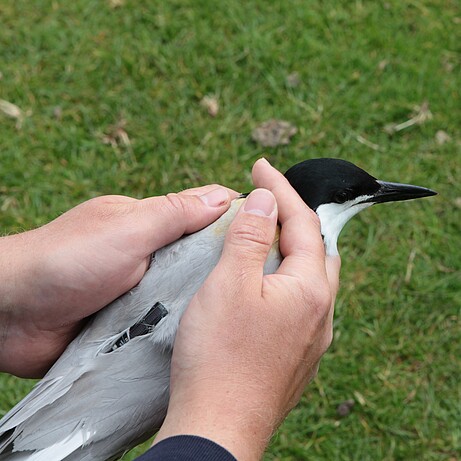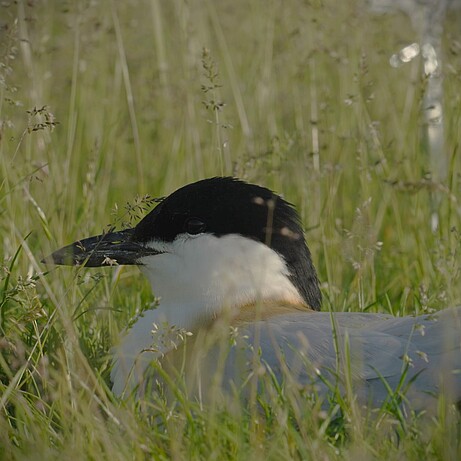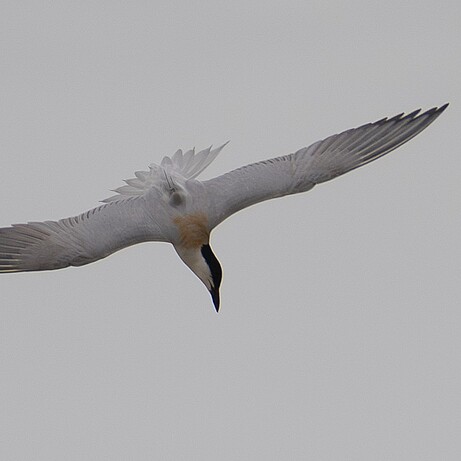



Terns on the move – spatial behaviour and its ontogeny in gull-billed terns
As part of the human-induced sixth mass extinction, large numbers of populations of migratory animals have been found to decline. If we are to develop and implement effective policies and measures to protect migratory species, we need to identify the causal pathways underpinning these declines. This process will require multiple steps. We will need to pinpoint when in the annual cycle threats to vital rates occur, and, specific to migratory species, where this happens. Only then can we make an inventory of potential factors responsible, test and identify these, and find ways to mitigate negative effects (Bouwhuis 2025).
For the last Central European population of gull-billed terns, a conservation project is in place to manage its breeding habitat and to fence in breeding pairs to minimise mammalian predation pressure. We have also started to investigate additional potential threats, such as loss of genetic diversity through isolation (Schnelle et al. 2024a), or diet-induced levels of environmental pollution (Schnelle et al. 2024b, Schnelle et al. 2025a,b). In each of these projects, however, we come to the same conclusion: we need to know more about the spatial behaviour of the birds, and how this develops. Because only when we know where birds forage, can we protect the resources (other than breeding habitat) available to them or understand sources of dietary environmental pollution. And only when we know how birds reach their wintering areas and where they then spend their winters, can we learn which factors might pose threats to them at this part of the annual cycle and range, or whether they interact with conspecifics from other breeding colonies and may display (natal) dispersal.
As such, we have carried out a pilot study during the breeding season of 2025, in which we equipped five adult breeding gull-billed terns with GPS devices. The study was a huge success. All birds returned to the nest after having been deployed, and resumed incubation duties. They displayed large inter-individual differences in their spatial behaviour around the colony, while being very individually repeatable across the season. In addition, two of the birds showed fascinating exploratory behaviour, visiting sites in the Netherlands and Denmark, which is begging to be understood and explained. During the next few seasons, and funded by the NaviSense Cluster of Excellence, we therefore hope to extend our pilot study and track breeding pairs of gull-billed terns, as well as their fledged offspring.
Publications
Bouwhuis S (2025) Terns in trouble: lessons from a long-term, individual-based study. In: East Atlantic Flyway Assessment 2023. The status of coastal waterbird populations and their sites. Eds. van Roomen M, Reneerkens J, Citegetse G, Crowe O, Gueye K, Langendoen T, Dodman T, Meise K, Schekkerman H. Wadden Sea Flyway Initiative p/a CWSS, Wilhelmshaven (Germany) Wetlands International, Wageningen (The Netherlands), BirdLife International, Cambridge (UK)
Schnelle A, Peter M, Müller C, Risch M, Liedvogel M*, Bouwhuis S* (2025b) A comprehensive assessment of contaminant exposure in an endangered tern population. Environmental Research 285: 122444 (*shared senior authorship)
Schnelle A, Risch M, Schupp PJ, Liedvogel M*, Bouwhuis S* (2025a) Sex- and age-specific mercury contamination in Central Europe’s last gull-billed tern population. Environmental Pollution 374: 126264 (*shared senior authorship)
Schnelle A, Winter M, Bouwhuis S, Risch M (2024b) Diet composition and reproductive performance in Central Europe’s last gull-billed tern population - a long term study. Ardea 112: 247-258
Schnelle A, Rollins RE, Cecere JG, Sánchez Gutiérrez J, Masero JA, Risch M, Bouwhuis S*, Liedvogel M* (2024a) Assessment of genetic diversity in a locally endangered tern species suggests population connection instead of isolation. Conservation genetics 25: 1313-1323 (*shared senior authorship)

